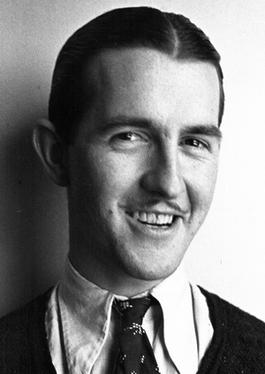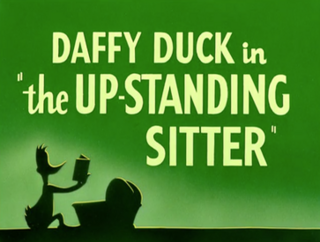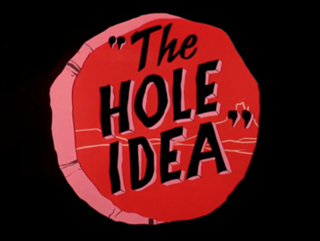
Robert Porter McKimson Sr. was an American animator and illustrator, best known for his work on the Looney Tunes and Merrie Melodies series of cartoons from Warner Bros. Cartoons and later DePatie–Freleng Enterprises. He wrote and directed many animated cartoon shorts starring Bugs Bunny, Daffy Duck, Porky Pig, Foghorn Leghorn, Hippety Hopper, Speedy Gonzales, and the Tasmanian Devil, among other characters. He also developed Bugs Bunny's design in the 1943 short Tortoise Wins by a Hare.

The Goofy Gophers are animated cartoon characters in Warner Bros.' Looney Tunes and Merrie Melodies series of cartoons. The gophers are small and brown with tan bellies and buck teeth. They both have British accents. Unnamed in the theatrical cartoons, they were given the names Mac and Tosh in the 1960s TV show The Bugs Bunny Show. The names are a pun on the surname "Macintosh". They are characterized by an abnormally high level of politeness.

Tweetie Pie is a 1947 Warner Bros. Merrie Melodies cartoon directed by Friz Freleng. The short was released on May 3, 1947, and stars Tweety with Sylvester, who is called "Thomas" in this cartoon.
Warner Bros. Cartoons, Inc. was an American animation studio, serving as the in-house animation division of Warner Bros. during the Golden Age of American animation. One of the most successful animation studios in American media history, it was primarily responsible for the Looney Tunes and Merrie Melodies series of animated short films. The characters featured in these cartoons, including Bugs Bunny, Daffy Duck, and Porky Pig, are among the most famous and recognizable characters in the world. Many of the creative staff members at the studio, including directors and animators such as Chuck Jones, Friz Freleng, Robert McKimson, Tex Avery, Robert Clampett, Arthur Davis, and Frank Tashlin, are considered major figures in the art and history of traditional animation.
Hop, Look and Listen is a 1948 Warner Bros. Looney Tunes cartoon directed by Robert McKimson. The short was released on April 17, 1948, and stars Sylvester and Hippety Hopper, in the latter's first appearance.

An Itch in Time is a 1943 Warner Bros. Merrie Melodies cartoon, directed by Bob Clampett. The short was released on December 4, 1943 and features Elmer Fudd, with a dog and cat that look similar to Willoughby and Claude Cat.

Walky Talky Hawky is a 1946 Warner Bros. Merrie Melodies theatrical short directed by Robert McKimson. The cartoon was released on August 31, 1946, and features Henery Hawk and Foghorn Leghorn. This is the first appearance of both Foghorn Leghorn and the Barnyard Dawg.

Acrobatty Bunny is a 1946 Warner Bros. Looney Tunes short directed by Robert McKimson. The short was released on June 29, 1946, and stars Bugs Bunny and Nero the Lion. This was the first cartoon McKimson directed that starred Bugs Bunny.

Daffy Duck Slept Here is a 1948 Warner Bros. Merrie Melodies cartoon, directed by Robert McKimson. The cartoon was released on March 6, 1948, and stars Porky Pig and Daffy Duck.

Buckaroo Bugs is a 1944 American Western Looney Tunes cartoon film directed by Bob Clampett. The cartoon was released on August 26, 1944, and features Bugs Bunny in his official Looney Tunes debut.

Birth of a Notion is a 1947 Warner Bros. Looney Tunes cartoon directed by Bob Clampett and Robert McKimson. The cartoon was released on April 12, 1947, and stars Daffy Duck.

The Up-Standing Sitter is a 1948 Warner Bros. Looney Tunes cartoon, directed by Robert McKimson. The cartoon was released on July 3, 1948, and stars Daffy Duck. All voices are by Mel Blanc.
Cheese It, the Cat! is a 1957 Warner Bros. Looney Tunes cartoon, directed by Robert McKimson. The short was released on May 4, 1957, and is the second of three McKimson cartoons parodying television's The Honeymooners.
The Astroduck is a 1966 Warner Bros. Looney Tunes cartoon directed by Robert McKimson. The short was released on January 1, 1966, and stars Daffy Duck and Speedy Gonzales.

One Meat Brawl is a 1947 Warner Bros. Merrie Melodies cartoon directed by Robert McKimson. The short stars Porky Pig and Barnyard Dawg, and was released on January 18, 1947. The title is a takeoff on the popular song "One Meat Ball".

Crowing Pains is a 1947 Warner Bros. Looney Tunes cartoon directed by Robert McKimson. The cartoon was released on July 12, 1947, and stars Henery Hawk, Sylvester, Foghorn Leghorn and the Barnyard Dawg. This is McKimson's first short to feature Sylvester.
This is a listing of all the animated shorts released by Warner Bros. under the Looney Tunes and Merrie Melodies banners between 1960 and 1969. A total of 147 shorts were released during the 1960s.

A Ham in a Role is a 1949 Warner Bros. Looney Tunes short starring the Goofy Gophers along with an unnamed dog who is based on stage/film actor John Barrymore. The cartoon was planned by Arthur Davis, but was finished and directed by Robert McKimson. It was released by Warner Bros. Pictures on December 31, 1949, but some sources list the release date as January 1, 1950. The cartoon draws heavily from the works of William Shakespeare, with its gags relying on literal interpretations of lines from Hamlet, Julius Caesar, Richard III, and Romeo and Juliet.

The Hole Idea is a 1955 Warner Bros. Looney Tunes cartoon directed and animated by Robert McKimson with character layout and background layout and paint by Richard H. Thomas. The short was released on April 16, 1955.














